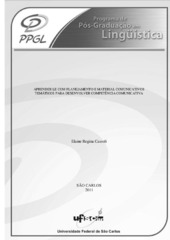Aprender LE com planejamento e material comunicativos temáticos para desenvolver competência comunicativa
Resumo
This qualitative, ethnographic-interpretative research aimed at analyzing the development of communicative competence of English Language undergraduate students of a private college in the center-western region of the state of São Paulo during their participation in a Thematic Task-Based Planning for English teaching and learning through classes guided by the use of a theme, the history of Great Britain, and communicative tasks with focus on meaning. The students' perceptions, feelings and how they behave throughout the process have also been investigated in this study. In order to collect the data, the following instruments have been used: initial and final cloze tests, three written evaluations throughout the process, audio recordings of tasks and written production of the tasks which have been previously performed orally and transcribed for analysis, plus questionnaires administered to students in different moments of the course. The framework is based on theoretical studies of theme and taskbased teaching of authors such as: Almeida Filho (1993, 1997, 1999, 2000, 2003, 2005, 2009); Barbirato (1999, 2005); Bygate, Skehan, Swain (2001); Candlin (1987, 2001); Crandall (1994, 2000, 2002, 2003, 2006); Ellis (2000, 2003); Nunan (1989, 2004); Prabhu (1987, 1990); Skehan (1998, 2001); Skehan, Foster (1997, 1999, 2001); Van den Braden (2006,2008); Willis (1996); Willis, Willis (2007), among others. The analysis has shown that the work combining theme-based teaching and communicative tasks could be an alternative for the teaching and learning of English in the context investigated, where it was previously found that most participants had limited linguistic and communicative competence in the target language. It was also possible to verify that the work with communicative tasks with focus on meaning and based on the theme of the history of Great Britain provided collaborative efforts among the students and opportunities for noticing the form, vocabulary or pronunciation of the target language. The data analysis also showed considerable improvement in the oral proficiency of the students in the target language.
